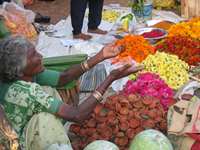Stainless steel colanders to strain boiled rice become filigreed lampshades. Hand painted metal trunks are mounted on castors for mobile fabric storage. Porcelain pickle jars of various sizes are reborn as stationery holders. The mix is intended to reflect the nature of the fashion brand and further shape its emerging identity.
As Krishnan, the architect for the studio says “The creative direction for the studio came from the brand itself. Trumpet by Meister gets its inspiration from flea markets and thrift shops to create a mix and match style. Call it clutter chic. Some objects are reused or customised to fit the look. The interior design followed a similar logic of reuse"
The design involved the fit out of a 350 square feet verandah of an old Dutch-style mansion. Due to the historic nature of the building, interventions to the structure were kept minimal. Thus all furniture is movable with the exception of adjustable wall shelves which can be dismantled if need be. The studio is kept sparse with a black and white palette. The restored black oxide floor complements the lime plastered walls. Light airy screens made from disused Kerala saris shield the view from the busy street outside.
"We looked around the bazaars close to our studio and were overwhelmed by the variety at hand. More choices than if we had walked into the international design furniture studio Ligne Roset. Some of the items we had settled on beforehand, like the trunks - some were a result of hanging around the stainless steel stores we love. The shopkeepers would invariably ask when we turned colanders upside down and held it above our heads. Once in a while we would even get a valuable suggestion on the proposed reuse”
It is really nice to know about this project and thanks to Krishnan for sharing with us his photos and his design ideas!
















